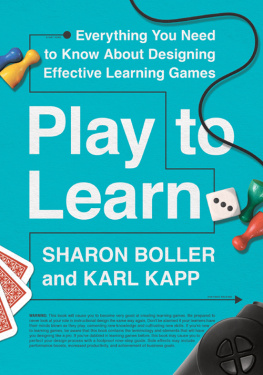Inhalt
DESIGN FOR KIDS
DIGITAL PRODUCTS FOR PLAYING AND LEARNING
Debra Levin Gelman

Design for Kids
Digital Products for Playing and Learning
By Debra Levin Gelman
Rosenfeld Media, LLC
457 Third Street, #4R
Brooklyn, New York
11215 USA
On the Web: www.rosenfeldmedia.com
Please send errors to:
Publisher: Louis Rosenfeld
Managing Editor: Marta Justak
Interior Layout Tech: Danielle Foster
Cover Design: The Heads of State
Indexer: Sharon Shock
Proofreader: Chuck Hutchinson
2014 Rosenfeld Media, LLC
All Rights Reserved
ISBN: 1-933820-30-6
ISBN-13: 978-1-933820-30-9
LCCN: 2014941138
Printed and bound in the United States of America
To Samantha, without whom this book would have been twice as long and half as good.
And to Josh, without whom this book would not have been at all.
HOW TO USE THIS BOOK
Who Should Read This Book?
This book is for anyone interested in designing digital experiences for kids, whether its creating a website, a game, a mobile app, or a piece of software.
You dont need to be a designer or a developer to understand this book, although it does assume some basic knowledge of design terminology.
Whats in This Book?
This book is divided into three sections.
The first section, , talks about why kids are fabulous, crazy, infuriating, and delightful to design for. It covers the basics of cognitive development, provides a framework for design, and draws connections between designing for kids and designing for other audiences.
, Kids and Design, describes the evolution of websites for kids, from the early days of the Internet through today.
, Playing and Learning, defines a framework for designing for child audiences and explains how principles we use to design for kids can be applied to adult audiences as well.
, Development and Cognition, dives into the stages of childrens cognitive growth and highlights key aspects of child development that are important to consider when designing for kids.
The second section, , provides detailed information on design patterns, principles, tools, and techniques to use with kids, as well as ways to conduct effective user research and testing.
, provides tips and techniques for kids ages 24. It focuses on designing for non-readers, using color judiciously, and creating an appropriate visual hierarchy, among other topics.
, Kids 46: The Muddy Middle, outlines approaches for designing for 46-year-olds, including social design, levels of feedback, and creative exploration.
, talks about what you need to know when designing for 68-year-olds. Topics include progression and leveling up, establishing rules for play, and self-expression.
, Kids 810: The Cool Factor, covers 810-year-olds, and includes issues like failure, complexity, advertising, and identity.
, discusses the nuances involved in designing for children ages 1012, who, despite being cognitively mature, still require some special treatment when it comes to digital experiences.
, Design Research, explores research techniques for kids of different ages. It includes information about recruitment, release forms, and parental involvement.
The third section, , brings all the information from the first two sections together, providing everything you need to create a great digital experience for children.
, An App for All Ages, demonstrates how design patterns evolve for kids of different ages. Youll see how a basic video-viewing app designed for an audience of 24-year-olds progresses into a complex entertainment repository for 1012-year-olds with playlists, favorites, and sharing.
, provides information about the business aspects of designing for kids, such as making your app available for download and getting your website up and running.
Throughout the book, youll find interviews and case studies from both kids and industry experts.
What Comes with This Book?
This books companion website ( rosenfeldmedia.com/books/design-for-kids/) contains a blog and additional content. The books diagrams and other illustrations are available under a Creative Commons license (when possible) for you to download and include in your own presentations. You can find these on Flickr at www.flickr.com/photos/rosenfeldmedia/sets/.
rosenfeldmedia.com/books/design-for-kids/) contains a blog and additional content. The books diagrams and other illustrations are available under a Creative Commons license (when possible) for you to download and include in your own presentations. You can find these on Flickr at www.flickr.com/photos/rosenfeldmedia/sets/.
FREQUENTLY ASKED QUESTIONS
How is designing for kids different from designing for adults? How is it similar?
Similar to designing for adults, designing for kids requires a strong understanding of your users and what they need and want. However, what differentiates designing for a child audience and an adult one is that children change really quickly. In just six months, a 2-year-old experiences significant cognitive, motor, and technical growth, while an adults skills in these areas remain pretty stable. Its important to keep these changes in mind as you develop sites and games that can grow with your audience.
Also, while adults usually have a clear end goal in mind when they use an interface, kids are in it for the journey. Just using a computer or an iPad is a treat for them. Its all part of the adventure. Youll still have requirements to follow and goals to achieve, but for the most part you can have a little more fun with the details. provides more information about these similarities and differences and what they mean when designing for different audiences.
How much do I need to know about childrens developmental stages in order to design for them?
Its good to have a basic understanding of where kids are developmentally when designing for them. While you dont need extensive knowledge of cognitive psychology, it makes sense to brush up on the stages of cognitive growth and maturation before starting a design project. In , youll find a primer on Piagets Stages of Cognitive Development, which will provide information about the various stages that children go through in order for you to design compelling experiences for them.
What rules and regulations do I need to be aware of when designing for children?
While there arent hard-and-fast rules for the design of sites and apps for children, many countries have strict regulations about the collection of personal information from kids younger than 13. You can find a detailed explanation of the U.S. COPPA (Childrens Online Privacy Protection Act) laws, which are among the most stringent, in my interview with Linnette Attai at the end of , These regulations state that parents or legal guardians must agree in writing to any information collected from kids that will be used to message them, market to them, or in any other way identify them, including any type of behavioral or geographic targeting.
In 2008, at the 30th International Conference of Data Protection and Privacy Commissioners held in Strasbourg, a Draft Resolution on Childrens Online Privacy was created. These guidelines are high level, but set the stage for international agreement about protecting kids identities online. They include a call for increased collaboration among designers, educators, parents, and kidsand the companies that create digital products for themto ensure that all personal information is protected.










 rosenfeldmedia.com/books/design-for-kids/) contains a blog and additional content. The books diagrams and other illustrations are available under a Creative Commons license (when possible) for you to download and include in your own presentations. You can find these on Flickr at www.flickr.com/photos/rosenfeldmedia/sets/.
rosenfeldmedia.com/books/design-for-kids/) contains a blog and additional content. The books diagrams and other illustrations are available under a Creative Commons license (when possible) for you to download and include in your own presentations. You can find these on Flickr at www.flickr.com/photos/rosenfeldmedia/sets/.